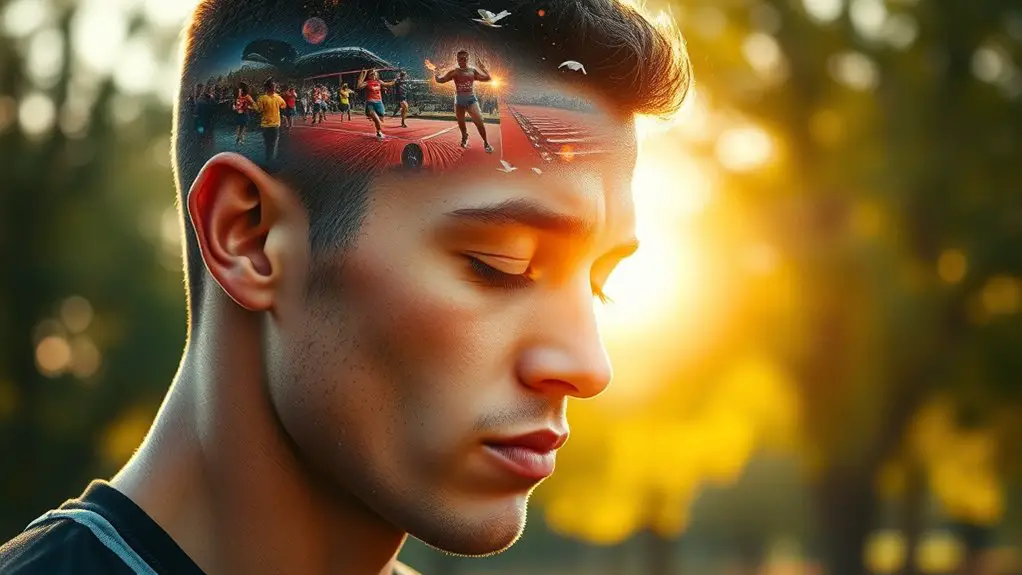Eye-tracking technology is transforming sports training by giving you real-time insights into your visual attention and decision-making. It captures gaze patterns to identify focus areas and improve performance in various sports like basketball, soccer, and tennis. By analyzing your eye movements, you can enhance your decision-making skills, concentration, and reaction times. This personalized training approach helps tailor your workouts for better outcomes. If you want to discover more about its applications and benefits, keep exploring this exciting topic.
Understanding Eye-Tracking Technology
Eye-tracking technology has become an essential tool in sports training, offering valuable insights into athletes' visual attention and decision-making processes. With technology advancements, you can now explore eye tracking applications that enhance performance and strategy. This innovative tool captures where you look during games, helping you understand your focus areas and blind spots.
Imagine being able to analyze your gaze patterns in real-time, allowing you to adjust your training for better outcomes. Coaches can use this data to tailor strategies, ensuring you play to your strengths while addressing weaknesses. Whether it's a soccer player monitoring opponents or a basketball player honing shooting skills, eye tracking can revolutionize your preparation.
The Science Behind Eye Movements
When you watch athletes in action, you might not realize how much their eye movements reveal about their performance. Understanding eye movement patterns and the importance of visual attention can help you analyze their reaction times and decision-making skills. This knowledge is essential for improving training techniques and enhancing overall athletic performance.
Understanding Eye Movement Patterns
Understanding how our eyes move offers invaluable insights into athletic performance and training. By analyzing eye patterns and gaze behaviors, you can reveal your potential and enhance your skills on the field or court. Your eyes tell a story about how you perceive your environment and react in real-time. For instance, tracking where you focus during gameplay can reveal your decision-making process and highlight areas for improvement. Recognizing these patterns helps you adapt and refine your techniques, leading to better performance. Embracing this knowledge not only empowers you but also fosters a deeper connection to the game. So, take the time to explore your eye movements, and you'll gain the freedom to elevate your athletic abilities.
Importance of Visual Attention
Visual attention plays a crucial role in how athletes perform, as it directly affects their ability to process information and react swiftly during competition. Your visual cognition depends on effective attention mechanisms, allowing you to focus on critical elements while filtering out distractions. This sharp focus can make all the difference in high-stakes scenarios.
| Aspect | Importance |
|---|---|
| Focus | Enhances performance |
| Reaction Time | Improves decision-making |
| Information Processing | Increases accuracy |
| Distraction Management | Maintains clarity |
| Skill Execution | Facilitates precision |
Analyzing Reaction Times
Eye movements can reveal a lot about an athlete's reaction times, as they often serve as a window into how quickly and accurately you process visual information. By using eye-tracking technology, coaches can assess your reaction time measurement during training sessions. This helps identify areas where you might improve your performance.
When you focus on a target, how your eyes move indicates your cognitive processing speed. For instance, if you fixate longer on an object, it may signal hesitation, while quick shifts suggest readiness. Understanding these patterns allows you to refine your skills, making you more agile and responsive on the field. Embracing this tech can empower you to unleash your full athletic potential.
Applications in Different Sports
While exploring the role of eye-tracking technology in various sports, you'll find that its applications are as diverse as the athletes themselves. This tech can enhance performance across multiple disciplines, helping athletes refine their skills and achieve peak performance.
| Sport | Application |
|---|---|
| Basketball | Eye-tracking aids shooting accuracy by analyzing focus points. |
| Soccer | It improves passing precision by monitoring player gaze. |
| Tennis | Athletes use it for serving techniques, maximizing ball contact. |
| Swimming | It helps in perfecting starts, enhancing reaction times off the blocks. |
| Golf | Eye-tracking assists in putting by focusing on the target line. |
| Baseball | It refines pitching strategies through visual patterns. |
| Hockey | Players enhance shooting accuracy by tracking the puck. |
| Cycling | It aids in sprinting techniques, focusing on best lines. |
Enhancing Decision-Making Skills
In sports, making split-second decisions can mean the difference between victory and defeat, and eye-tracking technology plays an essential role in sharpening these skills. By analyzing where your gaze lands, you can enhance your decision strategies and improve your cognitive flexibility. This technology helps you understand how to react in various situations, allowing for better performance under pressure.
Eye-tracking technology sharpens decision-making in sports, enhancing cognitive flexibility for better performance under pressure.
Here are some ways eye-tracking enhances your decision-making skills:
- Identifies patterns in opponents' movements
- Evaluates your response times to different stimuli
- Trains you to shift focus quickly
- Enhances situational awareness in high-stakes scenarios
- Allows for personalized feedback to refine strategies
With this technology, you can break free from conventional thought patterns, empowering you to make quicker, more effective decisions during competition. Embrace this innovative tool, and watch your game elevate to new heights!
Improving Focus and Concentration
When it comes to improving focus and concentration, eye-tracking technology can be a game changer. By enhancing your visual attention and analyzing your eye movement patterns, you can pinpoint areas for improvement. This approach not only sharpens your focus but also helps in training your mental resilience during high-pressure situations. Additionally, utilizing mindfulness in athletic performance can further enhance your ability to tune out distractions and maintain a competitive edge.
Enhancing Visual Attention
As athletes aim for peak performance, enhancing visual attention becomes essential for improving focus and concentration. Eye-tracking technology allows you to fine-tune your visual skills, boosting your cognitive training. By understanding where your gaze lands, you can sharpen your awareness and responsiveness in high-pressure situations. Here are some key benefits of enhancing visual attention:
- Increased situational awareness
- Better decision-making under pressure
- Improved reaction times
- Enhanced pattern recognition
- Greater adaptability to dynamic environments
Utilizing eye-tracking insights can help you recognize distractions and maintain focus, ultimately elevating your game. With a clear understanding of your visual strengths and weaknesses, you'll gain the freedom to perform at your best, no matter the challenge ahead.
Analyzing Eye Movement Patterns
Analyzing eye movement patterns reveals essential insights into how athletes focus and concentrate during performance. By engaging in eye movement analysis, you can uncover specific gazes and fixations that contribute to peak performance. This technology allows you to track where your attention lands and for how long, offering a clear picture of your focus habits. You'll discover which techniques enhance your concentration and help you remain in the zone, free from distractions. This process not only sharpens your awareness but also leads to significant performance enhancement. By understanding your eye movements, you can fine-tune your training strategies, ultimately allowing you to release your full potential and achieve the freedom to excel in your sport.
Training Mental Resilience
While developing mental resilience is essential for athletes, it's the ability to improve focus and concentration that often sets the best apart from the rest. Eye-tracking technology can help you refine these skills, enhancing mental toughness and cognitive endurance.
Here are some ways to harness this technology:
- Monitor gaze patterns to identify distractions.
- Practice maintaining focus during high-pressure situations.
- Analyze performance metrics to track progress.
- Engage in targeted visualization exercises.
- Set specific goals for concentration improvement.
Analyzing Reaction Times
Understanding how quickly athletes can react to visual stimuli is essential for enhancing performance, since reaction times often determine the outcome of competitive events. Eye-tracking technology allows you to conduct accurate reaction time measurements, providing insights into how quickly you can process information and respond. By analyzing these metrics, you can identify your strengths and weaknesses, helping you to refine your reaction skills.
When you know your reaction times, you can focus on performance optimization. This technology captures real-time data, showing you which visual cues prompt the fastest responses. You can then experiment with different stimuli during training to see what works best for you.
Tailoring Training Programs
With a solid grasp of your reaction times, you can start crafting personalized training programs that cater to your unique needs. Eye-tracking technology lets you pinpoint areas for improvement, allowing for customized drills tailored just for you. Here's how you can enhance your training:
- Identify specific skills to focus on
- Create drills that match your reaction speed
- Use performance feedback to track progress
- Adjust intensity based on your comfort level
- Incorporate varied scenarios to keep it engaging
Additionally, focusing on mental focus can significantly improve your overall reaction time and performance in training.
The Future of Eye-Tracking in Sports Training
As eye-tracking technology continues to evolve, its integration into sports training promises to revolutionize how athletes hone their skills. Future advancements could lead to more immersive training environments, allowing you to analyze your focus and decision-making in real-time. Imagine fine-tuning your performance based on precise data, enhancing your competitive edge. Incorporating biofeedback techniques can further enhance this process by providing insights into your physiological responses.
| Advancement Type | Benefits | Potential Challenges |
|---|---|---|
| Real-time Feedback | Immediate skill adjustments | Data overload |
| Enhanced Simulation | More realistic training scenarios | High costs of implementation |
| Personalized Insights | Tailored coaching experiences | Privacy concerns |
| Improved Recovery | Faster rehabilitation strategies | Technology reliance |
However, with these advancements come potential challenges. Balancing the use of technology with traditional training methods is essential. Embracing this future means maneuvering through these hurdles while maximizing the freedom to explore your full athletic potential.
Frequently Asked Questions
How Much Does Eye-Tracking Technology Cost for Sports Training?
When you're steering through the intricate landscape of eye-tracking technology, it can feel like sailing through uncharted waters. The cost analysis of such technology varies, typically ranging from a few hundred to several thousand dollars, depending on the pricing models you choose. If you're looking for freedom in your training regimen, investing wisely in this tech can open new horizons, enhancing performance while ensuring you're not anchored by unnecessary expenses.
Are There Any Risks Associated With Using Eye-Tracking Technology?
When using eye-tracking technology, there are some risks you should consider. Privacy concerns can arise since the technology captures detailed data about your eye movements. If this data isn't handled properly, it might lead to unauthorized access or misuse. Additionally, data accuracy can be an issue; if the system misinterprets your movements, it could lead to incorrect conclusions. It's crucial to weigh these risks against the benefits before diving in.
Can Eye-Tracking Technology Be Used for Injury Rehabilitation?
Absolutely, you can use eye-tracking technology in injury rehabilitation to enhance recovery. By integrating it with rehabilitation techniques, you can monitor your focus and visual attention, which are essential for athlete performance. This technology allows you to analyze how your eyes move during exercises, helping you identify areas that need improvement. Plus, it gives you the freedom to customize your rehabilitation plan based on real-time feedback, ultimately speeding up your recovery process.
What Sports Have Seen the Most Success With Eye-Tracking Technology?
When you think about sports benefiting from eye-tracking technology, basketball training and soccer analysis come to mind. In basketball, tracking players' gaze helps improve shooting accuracy and decision-making. For soccer, it enhances players' awareness of their surroundings, optimizing their positioning and passing. Both sports have embraced this tech to boost performance and elevate training methods. So, if you're looking for freedom in your game, eye-tracking could be the key to releasing your potential.
How Accessible Is Eye-Tracking Technology for Amateur Athletes?
Think of eye-tracking technology as a high-tech compass guiding your athletic journey. While it's become more affordable, an affordability analysis shows that many amateur athletes still find it a bit out of reach. However, as user experience improves and costs decrease, it's like opening a door to new training possibilities. Embracing this tech can empower you to elevate your game, giving you the freedom to explore your potential in ways you never imagined.



